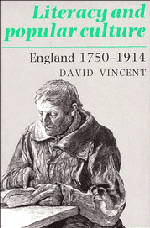Appendix A - Marriage register sample
Published online by Cambridge University Press: 03 May 2011
Summary
Through the work of R. S. Schofield up to 1840 and of the Registrar General from 1839 onwards, the general pattern of literacy in the period covered by this study has already been established. The purpose of this sample was to exploit the more detailed system of recording marriages established in 1837 in order to make a closer examination of the more important determinants of literacy during the final transition to a nominally literate society.
The major obstacle to the analysis of marriage registers after 1837 is the continuing unavailability of the records of all non-Anglican ceremonies. Although it is possible to purchase a copy of any specified marriage in the period, the Registrar General forbids access to complete registers held in his possession, which prevents any form of sampling across the entire population of marriage partners. In the early years of the new system, only a small proportion of brides and grooms chose to marry outside the parish church, but gradually the practice became more widespread, until by 1914, 17.6 per cent of marriages in England and Wales were conducted in Catholic, Nonconformist, Quaker or Jewish places of worship, and 24.1 per cent in the local registrar's office.
However, throughout the period, the incidence of non-Anglican marriages varied extensively across the country, and it was thought that it might be possible to counteract the dangers of drawing an increasingly unrepresentative sample by concentrating on Registration Districts with particularly high levels of ceremonies in the Established Church.
- Type
- Chapter
- Information
- Literacy and Popular CultureEngland 1750–1914, pp. 281 - 282Publisher: Cambridge University PressPrint publication year: 1989



